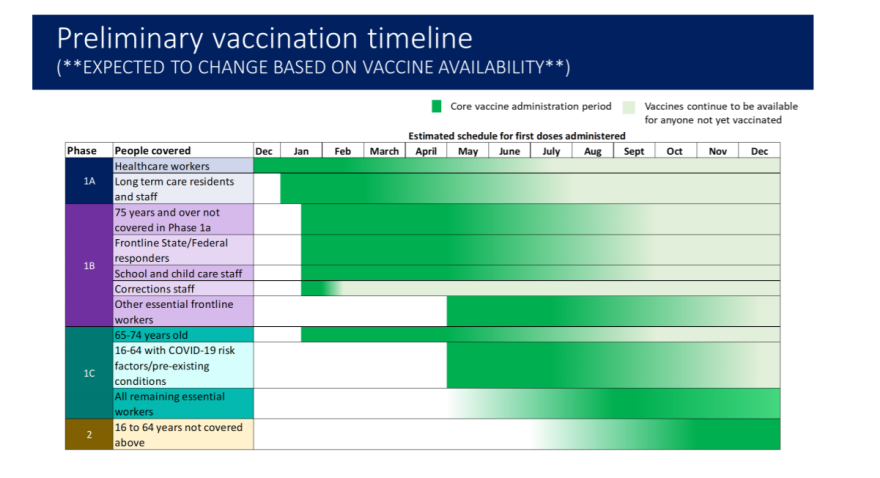It's been seven weeks since the first COVID-19 vaccines were distributed in Michigan and, as of Monday, the state has now officially seen over one million shots in arms.
The Michigan Department of Health and Human Services tracks its vaccine distributions in a dashboard that is updated throughout the week with metrics for first and second doses, doses by county, and more.
As of Sunday, more than 200,000 people are now fully vaccinated.
Detroiter Marilyn Robinson will join that group when she receives a second dose on Wednesday.
“I am going to allow my grandson and my granddaughter to come in and see me. They haven't been here for months and I miss them,” the 89-year-old Detroit resident said. “But I've asked them to wear masks just to be on the safe side.”
Robinson said she wouldn’t want to transmit the virus even if she has been inoculated, especially with the arrival of a more contagious strain in Michigan.
“I can't afford to let my guard down now,” Robinson said. "But I do feel comfortable that I at least have some protection.”
At the beginning of the vaccine rollout, there was confusion over how Michigan logged the number of vaccines distributed and the number of doses administered. State health officials explained then that there was no real-time dose tracker, meaning evaluating the data isn’t so simple.
(The graphic shows a reporting lapse during January 30 and 31.)
Emily Martin, an epidemiologist at the University of Michigan, said the numbers are still complex since the distribution of vaccines and administration of vaccines are pieces of information updated at different times.
“The information gets kind of decentralized soon, as doses go to various places,” she said.
“So it's kind of muddy water to try to figure out how fast we're moving from distributed to administration, especially since a lot of the administration is happening in these health systems kind of all over the place and they are all reporting their data a little bit differently.”
Martin said a lot of challenges also stem from the fact states aren’t sure how many vaccines are being produced.
“[With] all of the vaccination efforts that I'm familiar with, they're moving out the door almost right when they get it. There's a lot of challenges in kind of understanding the pace of the inventory and I think that's happening all over the country. And then getting things reported back in a way that makes sense.”
Dr. Joneigh Khaldun, the chief medical executive for the Michigan Department of Health and Human Services, addressed the country-wide issues before the U.S. House of Representatives Energy and Commerce Committee on Tuesday.
“Like many other states, Michigan’s single biggest challenge with the vaccine rollout has been the limited supply of vaccine available week to week and the lack of a national federal strategy until now,” she said. “Despite this, Michigan has made significant strides in implementing our vaccination strategy.”
The highlights
As of Monday, Michigan ranks 7th in total administered doses by state. When adjusted for population, however, the state fares differently, coming in 21st in administered doses adjusted for 100,000 people.
“I think we're on par for states that are similar to us in terms of similar density and similar size and similar balance of rural versus urban settings,” Martin said.
“I do think that we've got good infrastructure and I see a lot of work in a lot of communities to stand up for ways to move vaccines quickly,” she added. “And so I do feel confident that, hopefully, a valve will open, supply will start becoming available — once that comes through, we'll be able to move it quickly and communities are ready to deploy it.”
Vaccines are currently mostly administered by hospitals and most doses are going to those aged 50 and up.
According to the state health department’s dashboard, Oakland County leads the state with the highest total number of vaccines distributed and administered — but when adjusting for 100,000 residents, counties in Northern Michigan and the Upper Peninsula take the lead in vaccine distributions based on their populations.
Women are leading the vaccine makeup
Women make up 63% of first doses while men make up 37%.
Women make up 51% of Michigan’s population, and the same percentage of the state's confirmed COVID-19 cases. But for confirmed deaths, men exceed their population, compromising 53.3% of deaths from the virus. Michigan currently does not report vaccines by race or ethnicity.
Martin, the University of Michigan epidemiologist, said it is too early to tell what is driving the divide since the vaccine eligibility is limited and there could be data gaps from places that could skew reporting.
“We don't know if it's because women are more likely to take somebody up on a vaccine when they're offered, or because that women are more likely to be in some of the professions that are being prioritized for vaccination right now,” she said.
Sioban Harlow, a reproductive epidemiologist at the University of Michigan, pointed out that the 1A category of frontline workers for whom the state has prioritized vaccines — nurses and allied health professionals — are much more likely to be women. According to the U.S. Census Bureau, women make up 76% of all health care jobs. They also dominate the long term care sector.
Teachers and childcare staff, who are slowly getting vaccinated, are also more likely to be women.

Harlow also wrote in an email that women are much more likely to be in nursing homes and that women outnumber men in the 65 and above age category, both priority groups for vaccines.
But the patterns of who is taking up the vaccine will emerge once the vaccine is more widely offered.
That information, said Martin, is “going to be really informative, because it's going to help us learn whether certain groups of people might need more attention than others, to make sure that they know that that's available or to make it convenient for them to get it." She added that it will help public health officials “understand whether our messages about getting the vaccine are resonating with everybody equally, or whether there are groups that we can do a better job with.”
In the future
In a pandemic that has claimed 14,672 Michiganders, the milestone of 1 million shots delivered is good news. But with a population of almost 10 million, Michigan still has a journey ahead.
Martin said in a rough estimate, the state will ultimately need to vaccinate 80% of the population. But it’s complicated, since there isn't a vaccine approved for children and young teenagers yet.
“And we know that children can transmit the virus. And so our goals really have to be to vaccinate everybody that we can vaccinate.”
But she said if more than half of the population is vaccinated, there is likely to be less widespread community transmission. Instead, there will be hotspots, allowing officials to deal with the virus on a region-by-region basis rather than everywhere at once, she said.
But even with vaccines being put into arms, the social distancing and masking measures will be necessary to stop the spread of the virus — for now. The data on if a vaccinated person can have an asymptomatic infection that they can transmit to vulnerable people is still being figured out.
“I'm still masking and still social distancing,” Martin said, who has been vaccinated. “I'm still being cautious with my especially vulnerable people in my life that are unvaccinated. Because I don't want to be a source of transmission, even if I have a lower risk of getting sick from the virus.”
Want to support reporting like this? Consider making a gift to Michigan Radio today.







